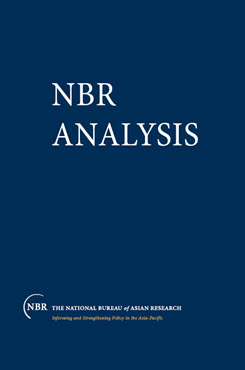Report from the NBR Analysis Series
Power Constrained
Sources of Mutual Strategic Suspicion in U.S.-China Relations
This essay highlights four sources of mutual strategic mistrust that, if insufficiently attended to by Washington and Beijing, will metastasize. These sources are: (1) defining the challenge of U.S.-China relations in such a manner that there is no “win-win” solution, (2) miscalculating U.S. and Chinese power, (3) desires in China to “change the game,” and (4) challenge and response dynamics. These four phenomena create a toxic mix that is corrosive to mutual trust and conducive to higher levels of future conflict if inadequately addressed in both nations.
Mutual strategic mistrust over the last decade and beyond has been evident in popular books and articles in both the United States and China, running the gamut from The Coming Conflict with China, China Can Say No, China Is Unhappy, Unrestricted Warfare, and The Coming Collapse of China to what is emerging as a “China on steroids” literature that includes When China Rules the World and the offensive realist and geostrategic theories of John Mearsheimer and Robert Kaplan. [1] One can hardly avoid the conclusion that the muscular elements of both societies find each other their most indispensable ally.
An oscillation in American views has said more about how Americans feel about themselves than about objective realities in the People’s Republic of China (PRC). In 2001, basking in the glow of the Soviet Union’s fall and the seemingly triumphant global march of market-based democracy, the United States felt good about itself—to many American observers China’s authoritarian system seemed to have limited prospects. In March 2001, Gordon Chang wrote:
Although the collapse of the Soviet Union has highlighted the deficiencies of moving too fast, Beijing is erring by progressing too slowly. Misery can hit from either direction. Mao said that it takes only one spark to start a prairie fire. The next spark could cause the conflagration that history will remember. Now it’s only a matter of time. [2]
Nearly a decade later, the U.S. economy was beset with negative GDP growth while China was in the medium-high single digits of positive growth. A new literature emerged, swinging to the opposite extreme, represented by (the non-American) Martin Jacques in his well-selling When China Rules the World. Before beginning the first section of his book, entitled “The End of the Western World,” he says:
Although we are witnessing the rise of a growing number of developing countries, China is by far the most important economically. It is the bearer and driver of the new world, with which it enjoys an increasingly hegemonic relationship, its tentacles having stretched across East Asia, Central Asia, South Asia, Latin America and Africa in little more than a decade….Given that China promises to be so inordinately powerful and different, it is difficult to resist the idea that in time its rise will herald the birth of a new international order.
This mutual strategic mistrust is evidenced not only in the scribbling of scholars and journalists in both countries…
[1] Richard Bernstein and Ross H. Munro, The Coming Conflict with China (New York: Alfred A. Knopf, 1997);Sung Qiang et al., Zhongguo keyi shuo bu [China Can Say No] (Beijing: China Industry and Commerce Press,1996); Sung Xiaojun et al., Zhongguo bu gaoxing [China Is Unhappy] (Nanjing: Jiangsu People’s PublishingHouse, 2009); Qiao Liang and Wang Xiangsui, Unrestricted Warfare (Panama City: Pan American Publishing, 2002); Gordon C. Chang, The Coming Collapse of China (New York: Random House, 2001); Martin Jacques, When China Rules the World: The End of the Western World and the Birth of a New Global Order (New York: Penguin Press, 2009); John J. Mearsheimer, The Tragedy of Great Power Politics (New York: W.W. Norton & Company, 2001); and Robert D. Kaplan, “The Geography of Chinese Power: How Far Can Beijing Reach on Land and at Sea?” Foreign Affairs (May/June 2010): 22–41.


